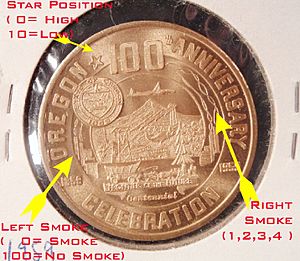Oregon Centennial Tokens facts for kids
Oregon Centennial Tokens were special metal discs, a bit like coins, made in 1959. They were created to celebrate 100 years since Oregon became a state. Many towns and cities in Oregon sold these tokens. They used the money raised to help pay for their big Centennial parties and events.
Contents
How the Tokens Were Designed
A company called Northwest Specialty Sales Co. helped design these tokens. They made many test versions. In the end, 38 different towns and areas bought these tokens for their celebrations.
Front and Back of the Tokens
Each town could choose how their tokens looked. The front of the token (called the obverse) always showed the official symbol for Oregon's 100th birthday. This was the same for all tokens.
The back of the token (called the reverse) could be changed a little. It had space for two special pictures or symbols, called logos. Each town decided which logos to put on their tokens. These logos were usually placed around the edge of the token.
What the Tokens Said
The most common message on the back of the tokens was: "Good For 50¢ in trade At any cooperative Business or Redeemable At face value at the (locality) (location) until 3 P.M. Friday Sept. 1959." This meant you could use the token like 50 cents at certain local stores. Or, you could trade it for 50 cents cash at a specific place in that town until September 1959. Some towns had slightly different wording, but this was the most common.
What the Tokens Were Made Of
Oregon Centennial Tokens came in different sizes, from about 32 to 40 millimeters across. They were also made from different types of metal.
Metal Choices for Towns
The company that made the tokens offered various metal options. Each town could choose which metal, or even several types of metal, to use for their tokens.
Special Edition Tokens
Some towns made a few special tokens using different metals than their main ones. These unique tokens were often given as awards or gifts. They were also used as special souvenirs for important visitors or people.


